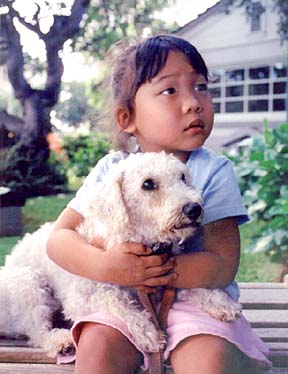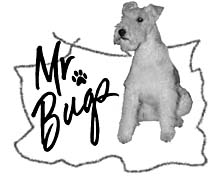
HAWAIIAN HUMANE SOCIETY PHOTO
Take responsibility for your dog by welcoming her as a member of your family, lovingly illustrated by Lauren Ko hugging her family dog, Lady.
If a dog started chasing you as you pedaled by on your bike, would you know what to do? What if a dog growled at you as you approached a neighbor's home? In certain situations, almost any dog could react aggressively, and that's why understanding dog behavior is important. Understanding dog
Canine body language
behavior can save you
from painful bitesBy Hawaiian Humane Society
There were 190 dog bite cases reported to the Hawaiian Humane Society in 2002. Most of these dog bite incidents could be prevented with three simple steps.
1. Learn more about dog behavior: It is instinct that causes a dog to defend himself, his human family and his territory, sometimes reacting aggressively if he perceives a threat. Big or little, the size and breed of the dog has very little to do with how a dog will react when frightened or threatened.
Human behaviors that are perceived as hostile to a dog include yelling, sudden movements and an outstretched arm, looking a dog in the eye and towering over the dog.
Children should be taught to avoid making these threatening movements and noises around dogs. Teach kids to avoid approaching a strange dog. People who understand dog behavior can avoid inadvertently triggering instinctive canine defense mechanisms.
2. Take responsibility for your dog: All owners of dogs are responsible for socializing their dogs properly. The dog most likely to bite is an un-neutered male who is tied up or confined in one small area apart from his human family. This situation is created by the dog's owner, not the dog.
Take responsibility for your dog by welcoming him as a loving member of your family. Take him to training classes, and increase his social contact with other people and dogs. Sterilization is affordable through Oahu's Neuter Now program and subsidized programs on other islands. Call and request brochures on dog training or Neuter Now: 946-2187, ext. 223.
3. Sign up for Mr. Bugs workshop: The Hawaiian Humane Society has developed the Mr. Bugs Dog Bite Prevention Program, which explains various dog behaviors and teaches people how to respond safely.
Those whose jobs take them door to door, as well as community organizations and school groups, can benefit from this free workshop. The 45-minute program consists of a presentation, a short video, a workbook and time for questions and discussion.
This educational program has been made possible through the generous support of Larry and Patricia Rodriguez in memory of Mr. Bugs, their wonderful, feisty fox terrier who gave them years of joy, love and companionship -- and chose his friends carefully. Schedule a Mr. Bugs workshop by calling 946-2187, ext. 222.
3. What to do when confronted by an aggressive dog: If you are chased or threatened by a dog, stop. Do not run, do not panic and do not stare into the dog's eyes. Face sideways and firmly tell the dog to "sit" and "go home." If you can, place an obstacle (bicycle, surfboard, purse) between you and the dog and slowly back away to safety.
If a dog attacks you, stop moving and let the dog bite any soft object you happen to have with you -- a backpack, jacket or purse. Shake and pull the object while the dog is gripping it and slowly back away sideways toward safety. Once you near a safe place, let the dog have the object.
If you do not have something for the dog to grab, stand quietly and put your hands in fists around your head and neck for protection. Move slowly toward safety while facing sideways to the dog.
If the dog knocks you down, lie quietly in the fetal position with your hands in fists around your head and neck. Remain in this defensive posture until the dog goes away or someone comes to your rescue.
If you are chased while jogging or bicycling, stop immediately. Put the bicycle between you and the dog, assume the sideways posture and back away slowly.
"Dogs are protective of their owners and homes," said Humane Society President Pamela Burns. "This makes them wonderful pets and companions. Yet when a dog feels threatened, he may react aggressively. The Mr. Bugs program is one more way the Humane Society is helping people and dogs live harmoniously together."
BACK TO TOP |
There are four basic types of dog behavior: playful, submissive/fearful, aggressive and prey-drive. Understanding canine
body languageA playful dog may jump up, bark and run around, but he is unlikely to bite.
A submissive or fearful dog, on the other hand, may not appear hostile, but he may well bite someone who comes too close or makes him feel cornered.
An aggressive dog often appears tense and may growl or snarl, a warning that he could bite.
A dog exhibiting prey-drive behavior is likely to chase any moving object. The potential for biting also is high in this situation.
If you are confronted by an unfamiliar dog:
>> Stop. Don't yell or panic.
>> Do not stare at the dog.
>> Stay calm, stand still, let the dog lose interest in you.
>> Face sideways and quietly talk to the dog.
>> If you can, put an obstacle (bicycle, surfboard, purse) between you and the dog.
>> Slowly back away to safety.Dogs most likely to bite:
>> Un-neutered male
>> Tied up or confined to small area
>> Not properly socialized
>> Protecting his home or family
Click for online
calendars and events.


